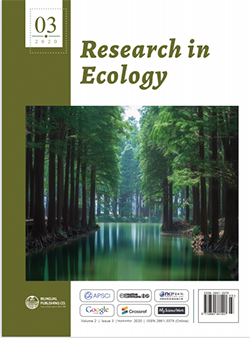
Local Community Participation in Rhino Conservation - Key to Conservation Success
DOI:
https://doi.org/10.30564/re.v2i3.2349Abstract
A robust framework to guide community engagement in sustainable wildlife conservation and illegal wildlife trade is lacking. Virtually all conservation bodies and players believe that local communities are key to the success of rhino conservation but they are not equally walking their talk. Bottom-up community-based initiatives help to curb poaching especially level one poachers. The multifaceted problem of the African rhinoceros poaching on the continent is approaching calamitous proportions, with astounding, sobering statistics revealing the sheer extent of the illegal practice today. Poverty, greediness, superstition, rampant corruption, unchecked social injustice, ruthlessness, and ignorance are fuelling the interplay of rhino horn demand and supply. In order to save the remaining rhinoceros species there is need for economic transformation which will benefit both the communities and wildlife. Communities should get direct financial benefits from rhinoceros conservation, capacitate them and always engage them in rhinoceros conservation matters. Rhino protection should be incentivized, increasing the number of local people benefiting from conservation, and decreasing hostility towards wildlife will motivate local people to fully embrace conservation efforts. These conservation efforts should first target level one poachers who are vulnerable and exposed, by developing a comprehensive profitable and lucrative community participation packages in all rhino properties. Conservationists should walk their talk and genuinely work with local communities to build support for rhino conservation through education, awareness, self-sustaining business ventures and employment.
Keywords:
Conservation, Communities, Rhinoceros, Participation, Poaching, IncentivizedReferences
[1] Biggs D, Cooney R, Roe D, Dublin HT, Allan JR, Challender DW, et al. Developing a theory of change for a community-based response to illegal wildlife trade. Conservation Biology, 2017, 31(1): 5-12.
[2] Bajracharya SB, Furley PA, Newton AC. Effectiveness of community involvement in delivering conservation benefits to the Annapurna Conservation Area, Nepal. Environmental Conservation, 2005, 32(3): 239-47.
[3] Child B. Evolution and innovation in wildlife conservation: parks and game ranches to transfrontier conservation areas: Earthscan. 2012.
[4] Moore M, Townsend M, Oldroyd J. Linking human and ecosystem health: The benefits of community involvement in conservation groups. EcoHealth, 2006, 3(4): 255-61.
[5] Pathak N, Kothari A. Sharing benefits of wildlife conservation with local communities: Legal implications. Economic and Political Weekly, 1998: 2603- 10.
[6] Saunders DA. The landscape approach to conservation: community involvement, the only practical solution. Australian Zoologist, 1990, 26(2): 49-53.
[7] Brandt JR, Van Coeverden de Groot PJ, Witt KE, Engelbrektsson PK, Helgen KM, Malhi RS, et al. Genetic structure and diversity among historic and modern populations of the Sumatran rhinoceros (Dicerorhinus sumatrensis). Journal of Heredity, 2018, 1: 13.
[8] Montesh M. Rhino poaching: A new form of organised crime. 2013, 27: 1-23.
[9] Hübschle A. The fight against poaching must shift to empowering communities. The Conversation. 2017a.
[10] ]Hübschle AM. The social economy of rhino poaching: of economic freedom fighters, professional hunters and marginalized local people. Current Sociology, 2017, 65(3): 427-47.
[11] FAIR PLANET. About the extinction of wildlife and its causes and significance: Article by Vince Barkas, 2019. wwwfairplanetorg/dossier/saving-rhinoceros/
[12] Sebele LS. Community-based tourism ventures, benefits and challenges: Khama rhino sanctuary trust, central district, Botswana. Tourism management, 2010, 31(1): 136-46.
[13] Ayling J. What sustains wildlife crime? Rhino horn trading and the resilience of criminal networks. Journal of International Wildlife Law & Policy, 2013, 16(1): 57-80.
[14] Bending ZJ. Improving Conservation Outcomes: Understanding Scientific, Historical and Cultural Dimensions of the Illicit Trade in Rhinoceros Horn. Environment and History, 2018, 24(2): 149-86.
[15] Biggs D, Courchamp F, Martin R, Possingham HP. Rhino poaching: Apply conservation psychology-Response. Science, 2013, 340(6137): 1168-9.
[16] Challender DW, MacMillan DC. Poaching is more than an enforcement problem. Conservation Letters, 2014, 7(5): 484-94.
[17] Smith RJ, Biggs D, St John FA, t Sas-Rolfes M, Barrington R. Elephant conservation and corruption beyond the ivory trade. Conservation Biology, 2015, 29(3): 953-6.
[18] Keane A, Jones JP, Edwards-Jones G, Milner-Gulland EJ. The sleeping policeman: understanding issues of enforcement and compliance in conservation. Animal conservation. 2008, 11(2): 75-82.
[19] Messer KD. Protecting endangered species: When are shoot-on-sight policies the only viable option to stop poaching? Ecological Economics, 2010, 69(12): 2334-40.
[20] Knapp EJ. Why poaching pays: a summary of risks and benefits illegal hunters face in Western Serengeti, Tanzania. Tropical Conservation Science, 2012, 5(4): 434-45.
[21] Jill A, Warren. Maroun, Barry Colin Atkins, Elisabetta B. From the Big Five to the Big Four? Exploring extinction accounting for the rhinoceros. Accounting, Auditing & Accountability, 2018, 31(2): 674-702.
[22] Oduor AM. Livelihood impacts and governance processes of community-based wildlife conservation in Maasai Mara ecosystem, Kenya. Journal of Environmental Management, 2020, 260: 110133.
[23] Mbanze AA, Ribeiro NS, da Silva CV, Santos JL. An expert-based approach to assess the potential for local people engagement in nature conservation: the case study of the Niassa National Reserve in Mozambique. Journal for Nature Conservation, 2019, 52: 125759.
[24] Spiteri A, Nepalz SK. Incentive-based conservation programs in developing countries: a review of some key issues and suggestions for improvements. Environmental Management, 2006, 37(1): 1-14.
[25] Roe D, Booker F. Engaging local communities in tackling illegal wildlife trade: A synthesis of approaches and lessons for best practice. Conservation Science and Practice, 2019, 1(5): e26.




 Admire Chanyandura
Admire Chanyandura





